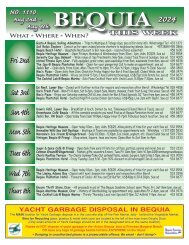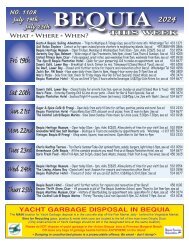Caribbean Compass Yachting Magazine - November 2020
Welcome to Caribbean Compass, the most widely-read boating publication in the Caribbean! THE MOST NEWS YOU CAN USE - feature articles on cruising destinations, regattas, environment, events...
Welcome to Caribbean Compass, the most widely-read boating publication in the Caribbean! THE MOST NEWS YOU CAN USE - feature articles on cruising destinations, regattas, environment, events...
Create successful ePaper yourself
Turn your PDF publications into a flip-book with our unique Google optimized e-Paper software.
YACHT INSURANCE IN THE CARIBBEAN<br />
What About Abandoned Wrecks?<br />
Joe Blow has insured his yacht. Hurricane Horrid comes along and sinks it. But the boat is repairable. The underwriter, at the<br />
underwriter’s expense, hires a salvor to raise it and organizes the haulout in a yard. At that point Joe takes over, repairs the boat,<br />
has the repairs certified, and then the underwriter pays Joe for the repair cost less the excess/deductable. Good brokers, working<br />
with good insurance companies usually organize an advance to the owner of 30 to 50 percent of the estimated repair costs.<br />
Sue Sailor doesn’t have insurance, and her boat is badly damaged, too. But she has the resources, time and skills to bring it<br />
back to life. Bobby Boater doesn’t have insurance, his boat is wrecked on the beach, and he just walks away, abandoning it.<br />
Unfortunately, there are too many like Bobby.<br />
by Don Street<br />
Abandoned wrecks cannot be blamed on insurance<br />
companies, as all good marine insurance policies have<br />
a wreck removal clause. If an insured boat is sunk in<br />
shoal water or blown ashore, and is repairable, it is the<br />
underwriter’s responsibility, at the underwriter’s<br />
expense, to deliver the wreck to a yard. If the boat is<br />
sunk or blown ashore, and is deemed a total loss, it is<br />
the responsibility of the underwriter to dispose of the<br />
wreck at the underwriter’s expense.<br />
With total losses the underwriters take a bad<br />
licking as they must pay the owner the insured<br />
1959. Some other sailors have successfully done the<br />
same operation. Others have bitten off more than they<br />
can chew, get partially through the refit, run out of<br />
money or enthusiasm, and walk away from the<br />
insurance companies.) If the boat is insured, no<br />
problem, the insurance company adds the cost of<br />
lifting and re-chocking to the damage claim.<br />
Uninsured boats that blow out of chocks or cradles,<br />
ROB KUNKEL<br />
‘Unless the owner has<br />
business interests on the<br />
island, or owns property there,<br />
there is little the government<br />
can do except bite the bullet<br />
and dispose of abandoned<br />
boats as cheaply as possible.”<br />
value of the boat plus they must pay the costs to<br />
have the wreck disposed of to the satisfaction of the<br />
local government. The insurance company sometimes<br />
finds the cheapest solution is to remove all fuel, lube<br />
oil and other substances that will pollute the ocean,<br />
and sink the wreck as a dive site and fish haven.<br />
Occasionally the underwriter suspects barratry, the<br />
intentional sinking of a vessel by owner or crew.<br />
Because of the wreck removal clause, the underwriter<br />
must salve the wreck and bring it ashore. But if<br />
barratry can be proved, the owner is paid nothing and<br />
a long court case follows. If it cannot be proved, the<br />
underwriter will say they will pay for repair costs less<br />
the excess/deductible when all repairs are finished<br />
and approved by underwriter. At that point the owner<br />
may walk away and the yard is stuck with the wreck<br />
as it is the property of the owner.<br />
Sometimes the owner will decide that with the<br />
insurance money received from a total loss, he or she<br />
can refloat the boat, move it to a repair yard and<br />
rebuild. That is how I re-acquired Iolaire in October<br />
project. This leaves the yard with a half complete, dead<br />
project — a real problem.<br />
The vast majority of abandoned wrecks are<br />
uninsured boats that have sunk or been blown out of<br />
their chocks ashore in a storm, and the foreign<br />
owner just departs. Unless the owner has business<br />
interests on the island, or owns property there, there<br />
is little the government or boatyard can do except<br />
bite the bullet and dispose of the wreck as cheaply<br />
as possible.<br />
Often when a boat blows out of chocks or a cradle,<br />
the yard charges the owner to lift and re-chock the<br />
boat. (It is worthy of note that after Ivan tore up<br />
Grenada, Grenada Marine lifted and re-chocked<br />
boats their own expense: no charge to owners or<br />
Sometimes a boat owner will decide that with the<br />
insurance money received from a total loss, he or she<br />
can move the boat to a repair yard and rebuild. But if<br />
there is no insurance, some owners just walk away.<br />
if badly damaged, can end up as the yard’s problem<br />
if the owner walks away.<br />
The problem of abandoned wrecks could be solved<br />
if all the island governments got together and<br />
required all yachts to have insurance. But that is<br />
probably not going to happen. Meanwhile, increasing<br />
numbers of marinas and boatyards require their<br />
clients to show proof of insurance, especially for<br />
hurricane-season storage.<br />
NOVEMBER <strong>2020</strong> CARIBBEAN COMPASS PAGE 15<br />
— Continued from page 13 …Is Your Boat Insured<br />
3) Stabilization<br />
First action! Learn how to treat for shock, stop bleeding, restore breathing, suture,<br />
bandage and hydrate a patient. Stabilizing the injured crewmate will go a long way to their<br />
survival. With the patient comfortable and secure below, there is now time to communicate.<br />
4) Communication<br />
If it’s time to call a telemedical organization, do you have a SatPhone, SSB radio,<br />
cell phone or satellite text/tracker? Then make the call. Within a minute, you can<br />
be listening to a doctor talk you through the patient’s stabilization, medication and<br />
first aid.<br />
5) Consultation<br />
This consultation goes on until you reach shore, or more serious action is required.<br />
6) Evacuation<br />
DAN and Global Rescue can make arrangements to fly the patient to a suitable<br />
medical facility (see above).<br />
Travel insurance<br />
Travel insurance might be worth having when making extensive explorations<br />
ashore. This topic is too extensive to address here, but a quick and handy way to get<br />
an overview of insurance for travelers outside their home country is at www.<br />
travelinsurance.com. This website lists the major travel insurance providers with an<br />
easy-to-fill-out form so you can compare services and prices.

















